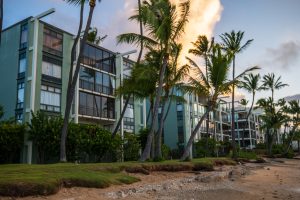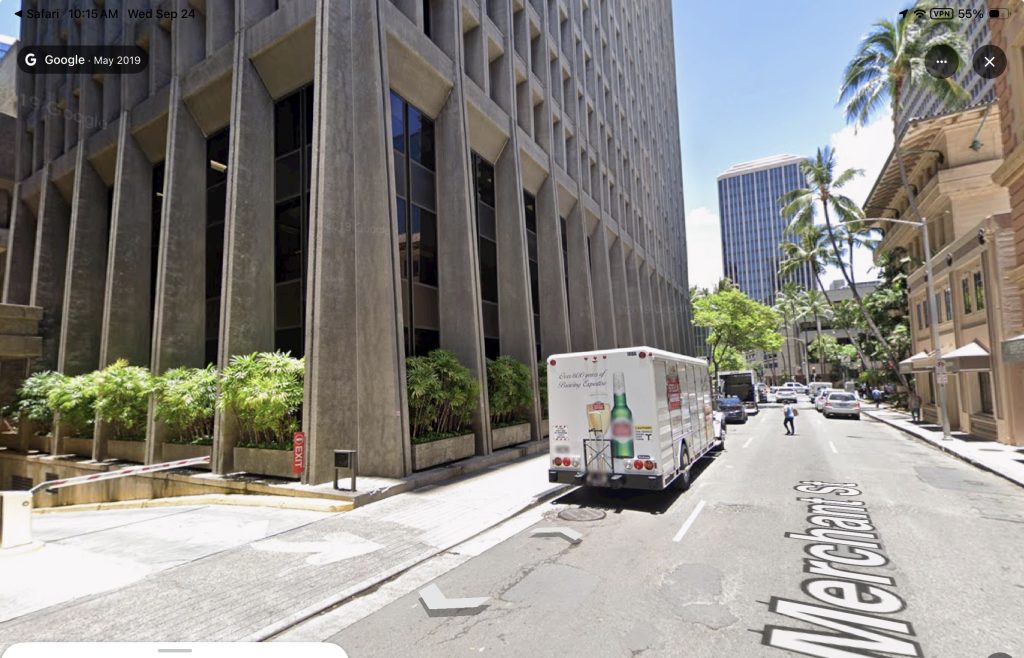Owners of apartments in the Kahala Beach Condominium are preparing to surrender their properties and walk away empty handed in just two years.
The original 60-year ground lease for the 196-unit oceanfront project expires on July 15, 2027, and ownership of the buildings will revert to the landowner, Kamehameha Schools, the charitable trust established in 1884 to benefit Native Hawaiians.
 Apartments in the Kahala Beach, nestled between the Waialae Country Club and the Kahala Hotel and Resort, range in size from 1,050 square feet to 3,510 sq. ft., and are spread across four 4-story buildings on 6.7 acres, with over 460 feet of beach frontage.
Apartments in the Kahala Beach, nestled between the Waialae Country Club and the Kahala Hotel and Resort, range in size from 1,050 square feet to 3,510 sq. ft., and are spread across four 4-story buildings on 6.7 acres, with over 460 feet of beach frontage.
Kamehameha Schools also owns the land under the neighboring Waialae Country Club and Kahala Resort and Hotel, but previously extended those leases to 2060 and beyond.
However, Kamehameha has declined to extend the Kahala Beach lease, and refused to consider several offers from the Assocation of Apartment Owners to purchase the fee interest.
Although individual lessees have purchased their condominium apartments, the leased land and any improvements (meaning the buildings themselves) revert to the landowner when the ground lease expires. Hawaii is one of the few places in the United States where leasehold residential properties are found.
This reality of just walking away is common with commercial leases. If a business lease isn’t renewed, the business owner simply packs up and moves on. But it is far less common for residential properties, given the idea that one’s home is their castle.
There haven’t been many examples of lease expirations leading to evictions. Owners of the Kailuan Apartments were evicted by Kaneohe Ranch at the expiration of their lease at the end of 2007. Although there was substantial negative publicity, the ranch proceeded with redevelopment of the property.
As the Kahala lease expiration nears, owners have reported Kamehameha Schools may offer month-to-month rebtals or short-term rental agreements, perhaps a year at a time, while working on a longer term development plan for the property.
During an extended legal battle over setting of the lease rent for the final 10-year term (2017-2027), consultants concluded the “highest and best use” would be an ultra-luxury condominium development that maximizes the site’s best attributes, such as its direct ocean frontage and allowable height and density. It’s current A-2 zoning imposes a 60-foot height limit, 50% higher than the current 40 foot building height.
However, redevelopment won’t be simple. The Kahala Beach condo was built a decade before the state enacted laws for coastal zone management to ensure access to and protection of the shoreline, and its development limits have become stricter over time. There has already been considerable erosion along the ocean side of the property which continues at a rapid pace.
With the effects of climate change and rising sea levels, the property is now in a designated high-risk flood zone. This requires a base flood elevation of 9 feet, which would reduce the size of any new development. Further, underground parking, as exists in the current buildings, would no longer be allowed for new construction on the site.
Other factors include stricter regulations for handling of stormwater, and new street regulations require wider roadways and fire truck turnarounds, which could impose additional limits.
These and other factors leave the future of the area in doubt. Only one thing is clear. Current owners in the Kahala Beach will have to surrender their apartments to Kamehameha Schools in 24 months, even if they are allowed to stay with temporary short-term rental agreements.
The building was a luxury address when it opened in 1967, but as the remaining term of the lease has dwindled, long-term owners have been fleeing, with just 34% of apartments now owner-occupied, according to the condominium’s latest biennial registration filed with the state. Many units are being used as high-priced vacation rentals.
Although the buildings appear relatively well maintained, visitors report apartment owners are now reluctant to invest in needed repairs and maintenance in their individual units, and conditions are deteriorating. Apartments have been selling over the last several years at what often seem like bargain prices for oceanfront living, except that lease rent and monthly maintenance fees can run over $5,000 monthly, and in two years the master lease will end.




